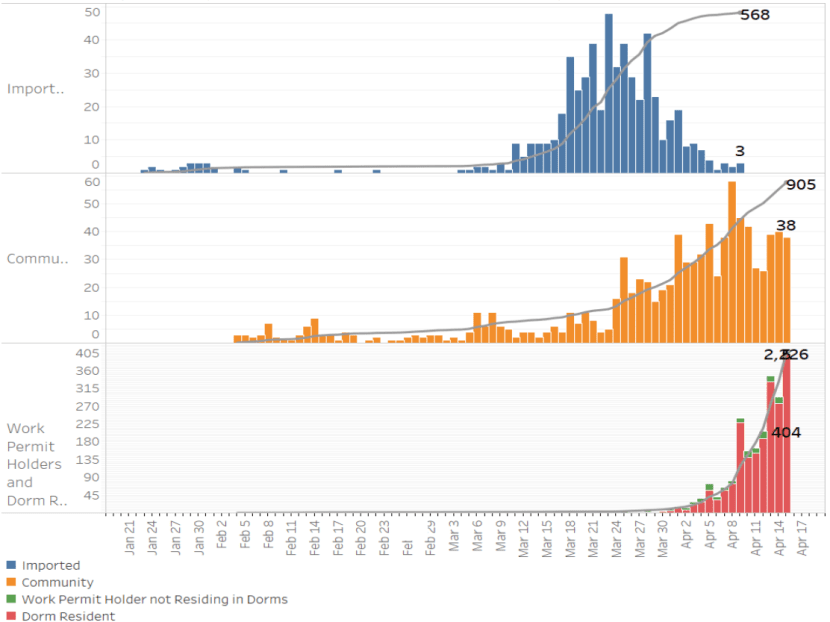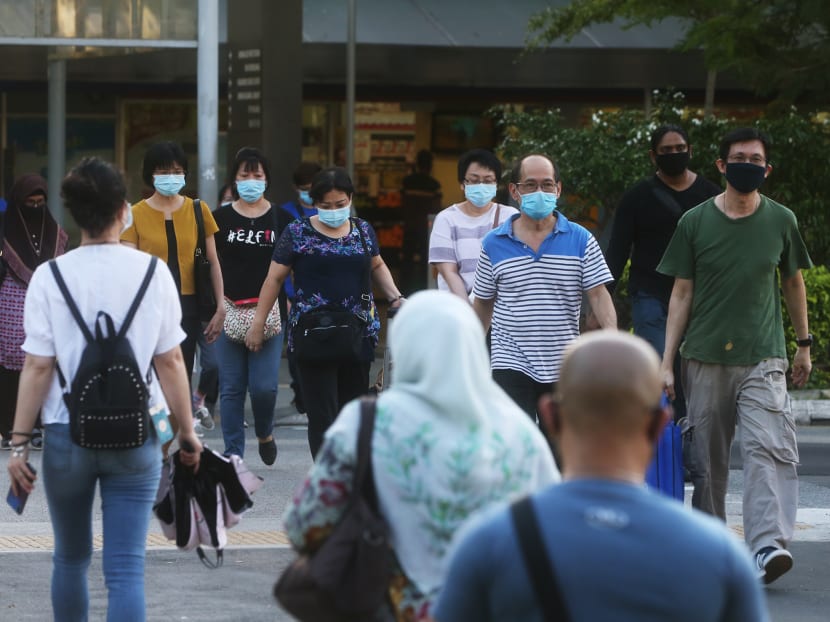Explainer: With the rise in unlinked cases, has community transmission become widespread?
SINGAPORE — The total number of Covid-19 cases in Singapore has tripled in the last two weeks, zipping past the 3,000 mark and fast approaching 4,000 infections.
SINGAPORE — The total number of Covid-19 cases in Singapore has tripled in the last two weeks, zipping past the 3,000 mark and fast approaching 4,000 infections.
On Wednesday (April 15), a record high of 447 new cases were reported, bringing the total number of cases to 3,699.
While the surge is largely due to new cases associated with foreign worker dormitories, the reports from the Ministry of Health (MOH) also show a rise in the number of unlinked cases.
As of Wednesday, 392 cases have been classified as unlinked, more than double the figure (177) from April 2.
Should the public be concerned by this? Has Singapore reached a situation where there is “widespread community transmission”? Is it true that up to 70 per cent of those infected could be asymptomatic, as what some recent research are saying?
TODAY approached some infectious diseases experts for the answers to these questions.
THE RISE OF UNLINKED CASES
Professor Ooi Eng Eong, who is the deputy director of the Emerging Infectious Disease Programme at the Duke-NUS Medical School, said the rise in unlinked cases could be due to a lag in contact tracing.
“We are seeing a high number of daily cases that require contact tracing... and that is not easy. Some people can’t even remember who they met five days ago. This is why it takes time,” he said.
At a media briefing on Tuesday, Associate Professor Kenneth Mak, the director of medical services at MOH, said active testing has been done in dormitories, and it takes time to compile and match the figures.
IS THERE WIDESPREAD COMMUNITY TRANSMISSION IN SINGAPORE?
A majority of the experts whom TODAY spoke to said that there is no large scale community spread happening here.
Associate Professor Alex Cook, who is the vice dean of research at the Saw Swee Hock School of Public Health, said: “I don't think the rise in the total case count indicates widespread community transmission, if we're talking about the general population and excluding foreign workers.

“If we had widespread community transmission, then we'd expect to see far more unlinked cases among locals being detected in primary care and the hospitals.”
Dr Leong Hoe Nam, an infectious diseases specialist, pointed out that although the numbers are rising, the bulk is from the dormitories.
MOH said on Wednesday that in the past two weeks, the number of new cases in the community outside of the dormitories has remained stable, with an average of 36 cases per day.
In comparison, the number of new cases among work permit holders has “increased significantly, from an average of 48 cases per day in the week before, to 260 cases per day in the past week, especially with our ongoing efforts to undertake more active testing of the workers”. The vast majority of these infections are residing in dormitories, MOH said.
COULD UP TO 70 % OF THOSE INFECTED BE ASYMPTOMATIC?
Experts do not believe as much as 70 per cent of those infected could be asymptomatic, saying some of them are likely to be “pre-symptomatic”.
People who are asymptomatic are those who carry the virus in their body but do not experience any symptoms.
Those who are pre-symptomatic have been infected and are incubating the virus but have yet to show symptoms.
Dr Paul Tambyah, president of the Asia Pacific Society of Clinical Microbiology and Infection, pointed to the Diamond Princess cruise ship where 712 of 3,711 passengers and crew tested positive, as an example.
Of the 712, 46.5 per cent were asymptomatic at the time of testing but the majority went on to develop symptoms, said Dr Tambyah.
“It is quite likely that there are a number of pre-symptomatic individuals from the unlinked clusters or the unidentified index cases who may be spreading the infection. It is critical to identify them, treat them and break the chains of transmission,” he added.
Assoc Prof Mak said: “Quite a number of cases are initially asymptomatic, but subsequently develop symptoms and it so happens that you have tested them just before they do. Rightly, they will probably be termed as pre-symptomatic.”
He added that among the workers who had been tested so far, there are those who fell into the pre-symptomatic category.
Agreeing, Prof Ooi said it could also depend on how accurately patients determine when their symptoms start. Many could develop mild symptoms only after their visit to the doctor.
That is why staying at home and keeping a safe distance from one another remain the driving forces to decrease transmission from those infected, he stressed.
ACTIVE TESTING OF FOREIGN WORKERS, INCLUDING THOSE WHO DO NOT SHOW SYMPTOMS
Even though there have been a number of asymptomatic or pre-symptomatic cases, foreign workers in dormitories previously were only tested when they developed symptoms.
This, however, has changed, with the authorities stepping up testing to include workers who are asymptomatic.
"In some dormitories, we have started work to screen close contacts of confirmed cases. For example, they may be fellow workers who share the same room and, because of their proximity of contact in their living arrangements, are deemed therefore as at higher risk," Assoc Prof Mak said.
"We also have tested various other foreign workers in different settings. For example, for some of the workers that have in fact been transferred out from the dormitories that are deemed as isolation areas, we've also tested as a precaution to make sure that as we transfer workers from one place to another, we're not also then seeding new areas, and therefore contributing causing more clusters."
Minister for National Development Lawrence Wong stressed at the multi-ministry task force briefing on Tuesday that the Government is continuing with vigorous contact tracing and quarantining.
“We said at the very start of this outbreak that the key to managing the spread of the virus is not just the measures that we have, but the pace at which we are able to adjust our strategies and adapt to a situation that is very fluid and changing very rapidly,” he said.









